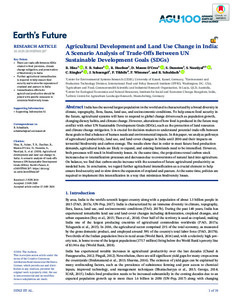Agricultural Development and Land Use Change in India: A Scenario Analysis of Trade‐Offs Between UN Sustainable Development Goals (SDGs)
| dc.date.accessioned | 2020-09-16T09:07:13Z | |
| dc.date.available | 2020-09-16T09:07:13Z | |
| dc.date.issued | 2020-01-15 | |
| dc.identifier | doi:10.17170/kobra-202009111792 | |
| dc.identifier.uri | http://hdl.handle.net/123456789/11817 | |
| dc.description.sponsorship | Gefördert durch den Publikationsfonds der Universität Kassel | ger |
| dc.language.iso | eng | eng |
| dc.rights | Attribution-NonCommercial-NoDerivatives 4.0 International | * |
| dc.rights.uri | http://creativecommons.org/licenses/by-nc-nd/4.0/ | * |
| dc.subject | SDGs | eng |
| dc.subject | land use change | eng |
| dc.subject | India | eng |
| dc.subject | biodiversity | eng |
| dc.subject | carbon sequestration | eng |
| dc.subject | agricultural development | eng |
| dc.subject.ddc | 630 | |
| dc.title | Agricultural Development and Land Use Change in India: A Scenario Analysis of Trade‐Offs Between UN Sustainable Development Goals (SDGs) | eng |
| dc.type | Aufsatz | |
| dcterms.abstract | India has the second largest population in the world and is characterized by a broad diversity in climate, topography, flora, fauna, land use, and socioeconomic conditions. To help ensure food security in the future, agricultural systems will have to respond to global change drivers such as population growth, changing dietary habits, and climate change. However, alterations of how food is produced in the future may conflict with other UN Sustainable Development Goals (SDGs), such as the protection of land resources and climate change mitigation. It is crucial for decision‐makers to understand potential trade‐offs between these goals to find a balance of human needs and environmental impacts. In this paper, we analyze pathways of agricultural productivity, land use, and land‐cover changes in India until 2030 and their impacts on terrestrial biodiversity and carbon storage. The results show that in order to meet future food production demands, agricultural lands are likely to expand, and existing farmlands need to be intensified. However, both processes will result in biodiversity losses. At the same time, the projections reveal carbon stock increases due to intensification processes and decreases due to conversions of natural land into agriculture. On balance, we find that carbon stocks increase with the scenarios of future agricultural productivity as modeled here. In conclusion, we regard further agricultural intensification as a crucial element to help ensure food security and to slow down the expansion of cropland and pasture. At the same time, policies are required to implement this intensification in a way that minimizes biodiversity losses. | eng |
| dcterms.accessRights | open access | |
| dcterms.creator | Hinz, Roman | |
| dcterms.creator | Sulser, Timothy B. | |
| dcterms.creator | Hüfner, Rebekka | |
| dcterms.creator | Mason-D'Croz, Daniel | |
| dcterms.creator | Dunston, Shahnila | |
| dcterms.creator | Nautiyal, Sunil | |
| dcterms.creator | Ringler, Claudia | |
| dcterms.creator | Schüngel, Jan | |
| dcterms.creator | Tikhile, Pavan | |
| dcterms.creator | Wimmer, Florian | |
| dcterms.creator | Schaldach, Rüdiger | |
| dc.relation.doi | doi:10.1029/2019EF001287 | |
| dc.subject.swd | Indien | ger |
| dc.subject.swd | Ernährungssicherung | ger |
| dc.subject.swd | Politisches Programm | ger |
| dc.subject.swd | Landnutzung | ger |
| dc.subject.swd | Nutzungsänderung | ger |
| dc.subject.swd | Biodiversität | ger |
| dc.subject.swd | Sequestrierung | ger |
| dc.subject.swd | Landwirtschaftsentwicklung | ger |
| dc.subject.swd | Klimaänderung | ger |
| dc.type.version | publishedVersion | |
| dcterms.source.identifier | EISSN 2328-4277 | |
| dcterms.source.issue | Issue 2 | |
| dcterms.source.journal | Earth’s Future | eng |
| dcterms.source.pageinfo | e2019EF001287 | |
| dcterms.source.volume | Volume 8 | |
| kup.iskup | false |
Dateien zu dieser Ressource
Das Dokument erscheint in:
-
Artikel [1223]


